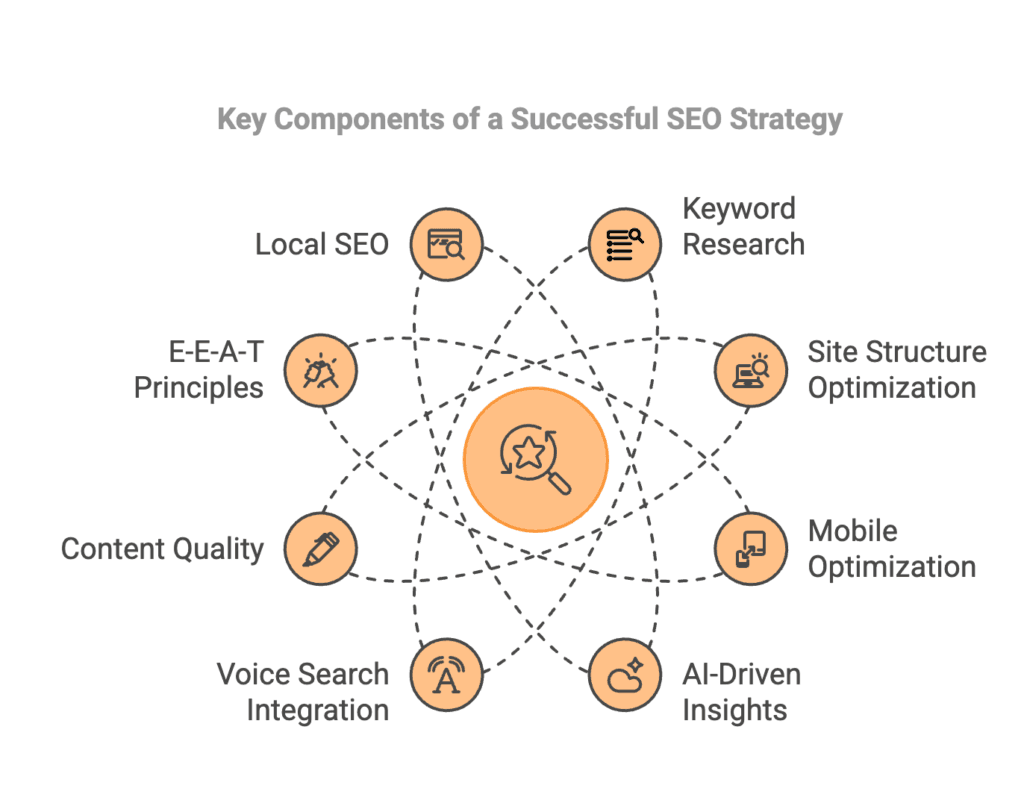
How to Create a Strong SEO Strategy in 2025

March 24, 2025
As we stepped into 2025, the digital landscape continues to evolve at an unprecedented pace. With search engines becoming increasingly sophisticated and user behavior shifting dramatically, businesses must adapt their SEO strategies to stay relevant. According to recent studies, over 63% of all organic search visits now come from mobile devices, emphasizing the need for a robust mobile optimization strategy. In this blog, we will explore how to create a strong SEO strategy that aligns with the latest trends and technologies, ensuring your brand stands out in the competitive online marketplace.
Understanding User Intent: The Heart of SEO
To craft an effective SEO strategy, it is essential to focus on user intent. This means understanding what users are genuinely searching for and tailoring your content to meet those needs. There are three primary types of user intent:
- Informational Intent: Users seeking knowledge want actionable insights and guidance. They’re looking for the latest trends, tools, and techniques to stay ahead.
Example: A blog titled “Top SEO Trends in 2025” attracts users searching for cutting-edge strategies. - Action-Oriented Intent: Users searching for “how to” phrases are looking for practical steps or frameworks to enhance their SEO strategies.
Example: A guide titled “How to Optimize Your Website for Mobile in 2025” provides actionable steps for marketers and business owners. - Future-Focused Intent: By including “2025,” users express interest in long-term strategies rather than just current best practices.
Example: A whitepaper titled “The Future of SEO: Predictions for 2025 and Beyond” appeals to forward-thinking professionals.
By aligning your content with these intents, you can create a more engaging user experience that resonates with your audience.
Key Components of a Successful SEO Strategy

1. Keyword Research: The Foundation of Your Strategy
Keyword research remains a critical component of any successful SEO strategy. In 2025, it’s essential to focus on semantic search and long-tail keywords that reflect user intent. Tools like Google Keyword Planner and SEMrush can help you identify relevant keywords with high search volumes and low competition.
Example: A travel blogger targeting “budget travel tips” should also consider long-tail keywords like “how to travel Europe on a budget” to capture intent-driven traffic.
2. Optimize Site Structure for Crawlability
A well-structured website is vital for both user experience and search engine visibility. Ensure your site is easy to navigate and that important pages are accessible within a few clicks. Use clear categories and subcategories to organize your content effectively.
Example: A well-structured e-commerce site ensures that a product page is reachable within three clicks from the homepage, making it easier for search engines to index.
3. Mobile Optimization: A Necessity, Not an Option
With mobile-first indexing now the norm, optimizing your website for mobile devices is crucial. According to Google, mobile devices account for over 63% of organic search visits in the U.S., making it imperative to provide a seamless mobile experience. Focus on responsive design, fast loading times, and simplified navigation to enhance user experience.
Example: A news website with a responsive design and fast-loading AMP pages ensures users can read articles seamlessly on any device.
4. AI-Driven Insights: Leverage Technology for Optimization
Incorporating AI tools into your SEO strategy can provide invaluable insights into user behavior and preferences. These tools can analyze data patterns, helping you make informed decisions about content creation and optimization.
Example: An online retailer uses AI-powered tools like Surfer SEO to analyze competitor data and optimize product descriptions for better rankings.
5. Voice Search Integration: Capturing Conversational Traffic
As voice search continues to rise in popularity, optimizing for conversational keywords is essential. Consider how users phrase their queries when using voice assistants and tailor your content accordingly. This approach will help you capture voice search traffic effectively.
Example: A restaurant optimizes its website for queries like “best pizza place near me” to rank higher in voice search results.
6. Content Quality: The Key to Engagement
Creating high-quality content that addresses user queries is paramount in 2025. Focus on producing informative, engaging articles that provide real value to readers. Incorporate multimedia elements like images and videos to enhance user experience further.
Example: A health blog publishes well-researched, reader-friendly articles with infographics and videos to improve engagement and retention.
7. E-E-A-T Principles: Establishing Trustworthiness
Google’s emphasis on E-E-A-T (Expertise, Authoritativeness, Trustworthiness) means that your content must reflect these qualities. Showcase your expertise by providing well-researched information backed by credible sources and references.
Example: A finance website includes author credentials, expert quotes, and links to authoritative sources to boost credibility.
8. Local SEO Evolution: Targeting Local Audiences
For businesses serving specific geographic areas, local SEO remains highly relevant in 2025. Optimize your Google My Business profile, ensure consistent business information across platforms, and leverage location-specific keywords to improve visibility in local searches.
Example: A bakery updates its Google My Business profile with high-quality photos of its products, accurate business hours, and responds to customer reviews promptly. As a result, it sees a 30% increase in local search rankings and a 20% boost in foot traffic within three months.
9. Backlink Building: Strengthening Authority
Building high-quality backlinks remains a cornerstone of effective SEO strategies. Consider guest blogging on reputable sites or collaborating with influencers in your industry to increase your backlink profile.
Example: A SaaS company gains backlinks by guest posting on industry blogs and collaborating with niche influencers. This strategy not only improves its domain authority by 15 points but also drives a 25% increase in organic traffic over six months.
10. Continuous Monitoring and Reporting
Regularly monitor your SEO performance through analytics tools like Google Analytics and SEMrush. Track key metrics such as organic traffic, bounce rates, and conversion rates to assess the effectiveness of your strategy.
Example: A digital marketing agency uses Google Search Console to track keyword rankings and adjust content strategies accordingly. By identifying underperforming keywords and optimizing content, the agency achieves a 40% improvement in keyword rankings and a 10% increase in client conversions within a quarter.
Conclusion: Future-Proofing Your SEO Strategy
As we sail through 2025, creating a strong SEO strategy requires an understanding of user intent, technological advancements, and evolving search behaviors. By focusing on mobile optimization, leveraging AI-driven insights, integrating voice search capabilities, and prioritizing high-quality content creation, businesses can position themselves for success in the competitive digital landscape.
Remember, SEO is not a one-time effort but an ongoing journey. Stay agile, adapt to changes, and continuously refine your strategy to stay ahead of the curve. With the right approach, your brand can not only survive but thrive in the ever-evolving world of search.
FAQs
It is not likely that people will feel left out in the 2025 SEO plan, but this time with the assistance of artificial intelligence. It does not have only keywords, but it also aims at user experience, E-E-A-T (Experience, Expertise, Authoritativeness, and Trustworthiness), and AI Overviews and other AI generative search products optimization to provide as much user experience as possible. It involves coming up with actionable detailed material that not only provides answers to user questions, but also have practical value to it.
Absolutely. The use of SEO is more than ever in 2025. Although the methods are changing, the ultimate value stays the same: it is the best method of establishing a sustainable and long-term flow of organic traffic. A solid SEO foundation makes your brand findable within the saturated digital space, creates trust and also yields a high ROI by showcasing itself to those willing to take action in search of what is being offered.
In order to ensure that your business reigns supreme in search in 2025 you must do more than rank on keywords. The trick is to emerge an all-in-one source of information to your audience. This implies building topical clusters on main topics, structuring the data so that the search engines know what your content is about, focusing on mobile-first indexing and Core Web Vitals in order to achieve a perfect user experience.
Artificial intelligence is not killing search engine optimisation but it is changing it. Consider 2025 whereby artificial intelligence is a potent helping platform that turns certain tedious tasks like keyword research, technical audit research, and even content ideation to a matter of a few clicks. It assists marketers in delving into large volume sets of data to understand some latent trends and anticipate user behaviors, thus, becoming more strategic and data-driven in terms of content creation and customization.
Modern SEO is user-intent-based. It is no longer a matter of doing a keyword match, but rather a matter of being able to think of the reasons why a user searched and feeding the user with content that will best satisfy that requirement. Through user intent, whether it is informational intent, commercial intent, and transactional one, you will enhance the user engagement by increasing engagement retention and reducing the bounces as well as making sure that search engines will consider your content as the most useful and helpful piece of information.
March 24, 2025
Recent Blogs







